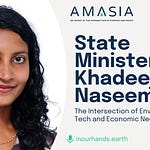In this episode from our archives, Ramanan speaks with Karen Seto, the Frederick C. Hixon Professor of Geography and Urbanization Science at the Yale School of the Environment.
She is an urban and land change scientist whose central research focus is how urbanization will affect the planet. A geographer by training, she integrates remote sensing, field interviews, and modeling methods to study urbanization and land change, forecast urban growth, and examine the environmental consequences of urban expansion. Seto is co-leading the urban mitigation chapter for the IPCC 6th Assessment Report and co-lead the same chapter for the IPCC 5th Assessment Report.
In this conversation, they discuss the urban heat island effect, carbon lock-in, and the social and environmental dimensions of sustainability. The full transcript is available above. This episode is also available on Apple Podcasts and Spotify.
In Our Hands is a production of Amasia. Follow these links for more about our firm, the Amasia blog, our climate fiction podcast, and Ramanan’s blog.
Highlights
[00:04:24] Politics and Urban Science
[00:07:36] Urban Heat Island Effect
[00:12:52] Social and Environmental Dimensions of Sustainability












